
September’s Topic of the Month – Skin Camouflage
 September 29th, 2016
September 29th, 2016 Nakita Cambow
Nakita Cambow Blog
Blog 0 Comments
0 Comments
What is Skin Camouflage?
Skin camouflage (sometimes called cosmetic camouflage) uses highly pigmented creams that are formulated to disguise scars, birthmarks, tattoos and skin conditions including rosacea, pigmentation and vitiligo. Skin camouflage products mimic normal skin tones and are significantly different from ordinary cosmetics.
When correctly applied they are extremely long-lasting, smudge-resistant, waterproof and sweatproof. This means that you can feel confident about the way you look – working out at the gym, swimming, going on holiday, attending a job interview or work meeting, starting a new school, having your photo taken, or wearing a fabulous wedding gown.
“I have ochronosis, possibly linked to my lupus. It causes a blue/black discolouration under the skin (which has been made worse by the drug mepacrine which I take for lupus). I have it on my legs, arms and abdomen. It has recently appeared on my face, around my eyes and cheeks. Ordinary makeup did not cover it up; I looked like I had two black eyes. My dermatologist referred me to the camouflage team which in my area is run by a charity. They were amazing and spent a lot of time trying the best products to cover it up, and showing me how to apply it. I then had a prescription request form to take to my GP. The makeup is amazing and has helped so much with my confidence. I only use it on my face as coverage elsewhere would be too extensive. I feel so much better about myself now. It’s difficult living with this as it looks like bruising and I have constant comments asking me what I have done! However well meant they are, it’s a constant reminder of how awful it looks and it’s permanent!”
How does Skin Camouflage work?
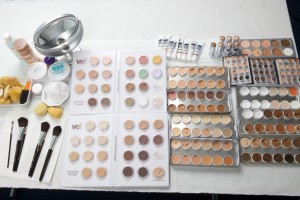 Part of using skin camouflage successfully is to match the colour of the products to your individual skin tone; only then will it look natural on the skin and give the best coverage. This is why buying products online, without first having a consultation, can be a frustrating and expensive experience. Your skin is as individual as you are and so skin tone matching is a real skill which practitioners build-up over time with training and experience. Camouflage creams are high in pigment – in other words, they have a lot of colour in them (much more than beauty-based foundations and concealers). This is what makes them so good at giving you a more even, uniform skin tone.
Part of using skin camouflage successfully is to match the colour of the products to your individual skin tone; only then will it look natural on the skin and give the best coverage. This is why buying products online, without first having a consultation, can be a frustrating and expensive experience. Your skin is as individual as you are and so skin tone matching is a real skill which practitioners build-up over time with training and experience. Camouflage creams are high in pigment – in other words, they have a lot of colour in them (much more than beauty-based foundations and concealers). This is what makes them so good at giving you a more even, uniform skin tone.
The products are removed easily with a cleansing cream or lotion with no ill effects or lasting implications for your skin. Using skin camouflage regularly, you get into a routine and applying the products becomes quick and easy.
Can I benefit from Skin Camouflage?
Skin camouflage products are suitable for men, women and children of all ages but not usually recommended for babies or very young children, unless suggested by their clinician.
Skin involvement is common in lupus, with 60-70% of people with lupus reporting some skin problem. Damage to the skin such as rashes, discolouration or depigmentation can occur as a direct result of lupus or sometimes as a side effect from certain medications.
Examples include;
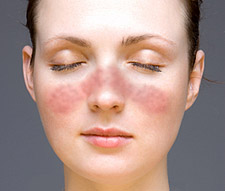 Malar (Butterfly) Rash – A butterfly rash is a reddish- or pink-coloured rash occurring on the cheeks and bridge of nose. Up to 60% of people with SLE will develop a butterfly, or malar, rash.
Malar (Butterfly) Rash – A butterfly rash is a reddish- or pink-coloured rash occurring on the cheeks and bridge of nose. Up to 60% of people with SLE will develop a butterfly, or malar, rash.
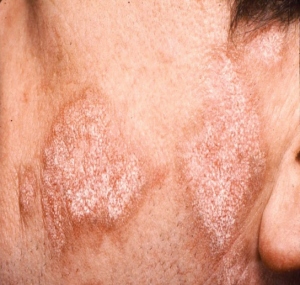 Chronic cutaneous lupus – There are several types of chronic cutaneous lupus with the most common form being discoid lupus erythematosus (DLE). All of them tend to occur for a long time and often leave permanent scarring and colour changes. After inflammation from cutaneous lupus resolves, sometimes the cells of the skin will produce more pigment (melanin) in those areas. This can unfortunately be a permanent problem, causing dark patches of skin to appear especially on the cheeks, forehead, nose, and ears.
Chronic cutaneous lupus – There are several types of chronic cutaneous lupus with the most common form being discoid lupus erythematosus (DLE). All of them tend to occur for a long time and often leave permanent scarring and colour changes. After inflammation from cutaneous lupus resolves, sometimes the cells of the skin will produce more pigment (melanin) in those areas. This can unfortunately be a permanent problem, causing dark patches of skin to appear especially on the cheeks, forehead, nose, and ears.
Subacute cutaneous lupus – Unfortunately when SCLE rashes heal they can cause permanent discolouration to the skin as areas of light- and dark-coloured splotches.
Anti-malarial medications – One of the potential long-term side effects of medications such as hydroxychloroquine, chloroquine and quinacrine is the development of dark-coloured patches on the skin which tend to develop on the legs, especially around the shins. They can however develop anywhere on the body with involvement of the neck being especially common. The colouration may decrease when the dose is reduced but since anti-malarials are the often the safest medications to treat SLE, is may be preferable to continue the medication instead of risking a flare.
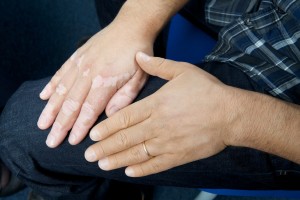 Vitiligo – This is an autoimmune disease, like lupus, which causes light-coloured areas to occur on the skin as a result of the immune system attacking the cells of the skin that produce melanin (which gives pigmentation).
Vitiligo – This is an autoimmune disease, like lupus, which causes light-coloured areas to occur on the skin as a result of the immune system attacking the cells of the skin that produce melanin (which gives pigmentation).
“I get lumps that are really inflamed and turn purple in colour. Not nice.”
“I’ve suffered with lupus for twenty-two years and have recently developed skin pigmentation which I’m very self-conscious about on my face.”
Skin Camouflage can be used to cover a wide number of conditions, including:
- vitiligo
- scarring – including acne
- rosacea/malar rash
- hyperpigmentation (melasma/chloasma)
- birthmarks
- stretch marks
- skin discolouration
- the area around a prosthetic
- other dermatological conditions
_
You should seek a medical diagnosis before considering skin camouflage and must seek further advice should there be any changes to the condition, or if any patch of skin appears different. It is advised that you discontinue skin camouflage until permission is given by your healthcare professional to continue usage.
Unfortunately, there are a number of situations where skin camouflage will not be the answer. These include open wounds, viral or fungal infections, dermatitis, allergic reactions, skin cancers and contagious illnesses affecting the skin e.g. chicken pox or measles. A full list of conditions for which skin camouflage is contraindicated can be found HERE.
What services are available?
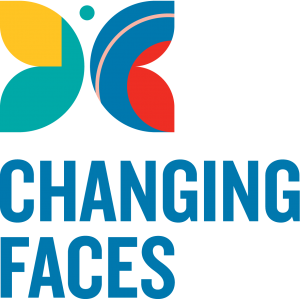 Changing Faces took over the skin camouflage service from the Red Cross in 2011 and has about 120 skin camouflage practitioners across the UK, working out of GP surgeries, health clinics, hospitals, Red Cross and Changing Faces offices. The service is provided free of charge and they welcome donations. If you are a UK resident, you can ask your GP or other health or social care professional for a referral to the service. In some areas, you can refer yourself. Information about the location of the centres and how to self-refer can be found HERE.
Changing Faces took over the skin camouflage service from the Red Cross in 2011 and has about 120 skin camouflage practitioners across the UK, working out of GP surgeries, health clinics, hospitals, Red Cross and Changing Faces offices. The service is provided free of charge and they welcome donations. If you are a UK resident, you can ask your GP or other health or social care professional for a referral to the service. In some areas, you can refer yourself. Information about the location of the centres and how to self-refer can be found HERE.
“I’ve used the service. My rash comes and goes, and inevitably when I had my appointment there was no rash! But the lady I saw was lovely and matched my skin tone and taught me how to apply it. Then I can just put my normal make up on top. I wish I had known about this years ago.”
“Changing faces are great! One of my lupus symptoms is alopecia. One year the bald patch on the crown of my head got bigger and bigger. I have very thick hair but the bald patch was becoming un-coverable and I was very self-conscious and upset by it. I was referred to Changing Faces, who I saw at my local hospital. They were wonderful. I was given some camouflage cream to match the colour of my hair – they informed me that they had never colour matched for a scalp before but this didn’t put them off. I would apply the cream to the bald patch, put on some fixing powder and the bald patch blended into my hair and became almost invisible. I did this until the hair started to grow back. Without Changing Faces I think I would have had a very different and unhappy 6+ months that year.”
“I went when my face rash was at its worse. It’s like magic. I don’t need it as much these days but when I’m having a flare it helps me face the world. It covers everything; rashes, scarring and it’s waterproof and can be worn for 48 hours. You can self-refer for an appointment. As it’s a charity the appointment is free. They then match your skin to a foundation and powder, show you how to apply it and send a letter to your GP to get the makeup on prescription.”
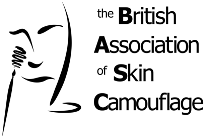 The British Association of Skin Camouflage (BASC) has a nation-wide network of graduates who are able to offer a consultation service within the NHS and in private practice. Access to free clinics provided by BASC trained consultants within the NHS will require referral in accordance with local agreements. BASC trained consultants providing services within private clinics and high street salons will accept self-referrals, but a consultation fee may apply. For details of your nearest BASC camouflage clinic you can contact them HERE.
The British Association of Skin Camouflage (BASC) has a nation-wide network of graduates who are able to offer a consultation service within the NHS and in private practice. Access to free clinics provided by BASC trained consultants within the NHS will require referral in accordance with local agreements. BASC trained consultants providing services within private clinics and high street salons will accept self-referrals, but a consultation fee may apply. For details of your nearest BASC camouflage clinic you can contact them HERE.
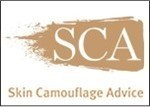 Skin Camouflage Advice (SCA) is run by Rowena Wilson who is a freelance makeup artist and skin camouflage practitioner. Rowena carries out individual consultations in Warwickshire and the West Midlands. She can also put you in touch with other suitably qualified practitioners in your local area. The current charge for an individual skin consultation with Rowena Wilson is £65.00 (2016 prices). You can find more information HERE.
Skin Camouflage Advice (SCA) is run by Rowena Wilson who is a freelance makeup artist and skin camouflage practitioner. Rowena carries out individual consultations in Warwickshire and the West Midlands. She can also put you in touch with other suitably qualified practitioners in your local area. The current charge for an individual skin consultation with Rowena Wilson is £65.00 (2016 prices). You can find more information HERE.
What will happen at an appointment?
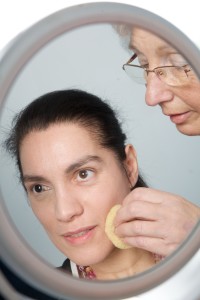 Consultations may take up to about one hour with one visit usually being sufficient.
Consultations may take up to about one hour with one visit usually being sufficient.
At first your Skin Camouflage Practitioner will ask how they can help you and they will discuss the specially formulated creams and setting powders. Your Practitioner will explain about the colour-matching process and will test small amounts of cream on the area you want to camouflage, until you have a match you are happy with. After this, they will apply the cream to the specified area and set the application powder.
Your Practitioner will explain and demonstrate what they are doing and you will be able to look in a mirror to watch the process. You will then have the opportunity to practice applying the products yourself.
When you are happy with the outcome, your Practitioner will write out a Prescription Request Form to take to your GP who may give you a prescription for the recommended products. Your Practitioner will also give you an information leaflet, which they will go through with you so that you remember how to apply and remove the cream and powder. This leaflet will also contain the brand and colour code of the recommended cream(s) and powder(s) plus a phone number for any queries.
Please note that each condition is different and although Practitioners will do their best, perfect coverage is not always possible.
Are Skin Camouflage Products Available on Prescription?
 NHS England currently lists brands of camouflage within the British National Formulary, the Drug Tariff and the Monthly Index of Medical Specialities (Borderline Substances) for reimbursement on form FP10. This means that many of the products used by skin camouflage practitioners are available, at doctor’s discretion, on NHS prescription.
NHS England currently lists brands of camouflage within the British National Formulary, the Drug Tariff and the Monthly Index of Medical Specialities (Borderline Substances) for reimbursement on form FP10. This means that many of the products used by skin camouflage practitioners are available, at doctor’s discretion, on NHS prescription.
The computer says “No”.
Many people may experience difficulty when the healthcare advisor attempts to create an electronic prescription. A probable explanation is that there are various software programmes in use to create prescriptions electronically, and no single programme lists everything available on the current Drug Tariff, MIMS, etc. A solution is to hand-write the prescription, or add the product to the software.
The Pharmacist says “which colour?”
Pharmacists and NHS personnel may report that only two colours are listed against a brand name. Please refer to the above answer regarding this question, or double check against the GB Distributor’s website.
The electronic prescription does not give a column for the colour code.
The solution is to always list the brand in the main text column but place the colour code (or colour name) and quantity in the “dosage” column.
My healthcare professional says camouflage is “…only for scars, portwine stains and vitiligo”.
A product marked as ABCS (Approved by the Committee on Borderline Substances) includes such items as sunscreens, emollients, nutritional aids, etc., as well as skin camouflage. Borderline Substances are available on prescription at doctor’s discretion. However, because there is no national (or even local) agreement of opinion, some medical professionals interpret the ‘indications’ to be the finite guide and only prescribe for those mentioned as such in MIMS. The Drug Tariff does not mention scarring or name any dermatosis, which suggests that there is no restriction, other than known contra-indications.
Recommended Products
Many people with lupus have sent us their personal recommendations and experiences of cosmetic products they’ve used for skin camouflage;
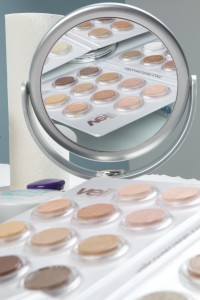 “I wear Double Wear foundation by Estée Lauder. It gives good coverage.”
“I wear Double Wear foundation by Estée Lauder. It gives good coverage.”
“I’ve got really sensitive skin and my face goes purple, especially the ‘butterfly’ area. I’ve tried all kinds of makeup and had a makeup artist have a go. It seems I’m allergic to most things! I’m currently using Younique foundation, which is mineral-based. It’s so light I don’t even know I’m wearing it and the coverage is amazing; it doesn’t leave any purple areas showing at all. It’s a bit more expensive than I would like but FM also does a mineral range which provides just as good coverage and is more affordable.”
“I have a terrible lupus rash. It gets worse when the sun is out. I’ve found that mineral makeup from Lily Lolo is very effective at covering it. I use the BB cream, mineral foundation and then finishing powder. I did try Bare Minerals but it wasn’t as good and it was twice the price!”
“I use Clinique products. The malar rash can be a bit glowing so first I use Redness Solutions which is green. Yes, it sounds off-putting but it really does cover the red patches. Then I use Line Smoothing Concealer which is matched to your skin tone and is perfect for those black bags I have gained under my eyes, being so very tired all the time. The lift both products give me is worth every penny. Though they are not cheap, they stay put all day, last for ages (because you use so little) and they really do add a bit of glow to my face; highly recommended.”
“I have tried just about everything out there. For me the IT cosmetic products work the best. The foundation I use is called “Your Skin But Better”. The lady who developed them with dermatologists and plastic surgeons has severe rosacea. It completely covers all severe redness and is SPF 50 to boot. It’s worth a try if you have redness of face and neck as I do with SLE. My rashes in my face and neck never go away. When you have it on you cannot see the redness at all, it’s completely covered. It also has built in primer so you don’t have to put any green undercoat on; it makes it all very simple.”
“I tend to get a rash along my jaw and chin, so I can manage to hide things by contouring (when I have the energy). I use Mac Cosmetics, which has good coverage and then use counter-contour for dark circles under the eyes (I haven’t slept through the night in years so these are a given). I use SunSense invisible tint 50+ sunscreen, which doesn’t give me that obvious sunblock sort of look, and doesn’t interfere with coverage. What I’ve found with coverage is it’s not about coating it on, but finding the right tint – if you have a reddish/purple rash, you want to go with something slightly green, maybe a bit of yellow. For my dark circles, I go with a mix of orange and pink (yes, I know it sounds weird but it works well) and it doesn’t need to go on thick! I have a velvet-type brush applicator and a teardrop sponge which helps apply product without getting too cake-y. What I’ve also found is I’m often too tired to do the ‘full look’ so if all I can do is foundation, that’s what I do (and I don’t bother with anything else), then whack on some lip gloss and I’m done. Any routine needs to be brief enough to be able to do it consistently or I just run out of spoons!”
***Please note that this article is written for informational purposes only and should not be a substitute for professional medical advice or treatment. Do not delay seeking or disregard medical advice based on information here. Always seek the advice of your local family physician or other qualified health professional before starting any new treatment or making any changes to existing treatment. It is also advisable to consult a medical professional before making any changes to diet or starting alternative remedies, which may interact with other medications.***
Thank you so much to everybody who submitted their tips and experiences for this month’s topic. We’re sorry if we weren’t able to use your comment in the article this time.

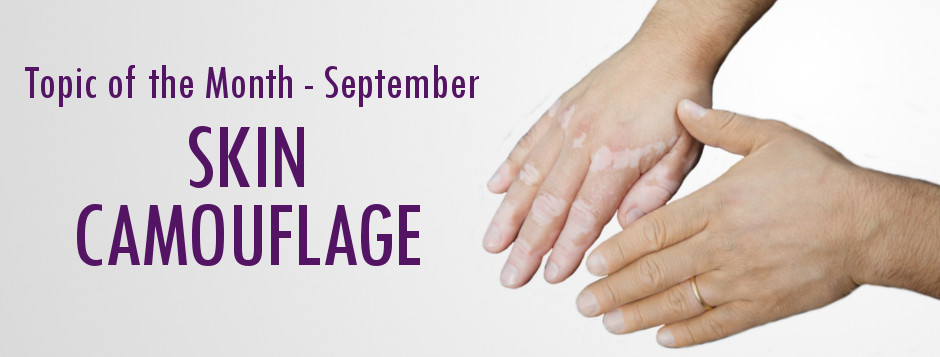

 ©2024 LUPUS UK (Registered charity no. 1200671)
©2024 LUPUS UK (Registered charity no. 1200671)